A barbell is one of the most utilitarian pieces of home gym equipment one could have at their disposal and the Living.Fit Barbell is one of our favorites on the market. Home gym owners tend to look for a jack-of-all-trades barbell, and this bar does not disappoint. The brass bushings and ball bearings in the loading sleeves provide adequate spin for Olympic and CrossFit lifts, it can handle up to 1,500 pounds and has a tensile strength rating of 200,000 PSI.
You won’t spend more than $225 on this bar whether you opt for the chrome or cerakote coating. The knurling is fairly moderate, ideal for a bar that you can deadlift with one minute and then power clean the next. We’ve tested a lot of barbells in our time, and due to the sub $230 price tag, the moderate knurling, and the solid spin in the loading sleeves, this barbell from Living.Fit can bring excellent value to your iron paradise. Tag along for a full breakdown.
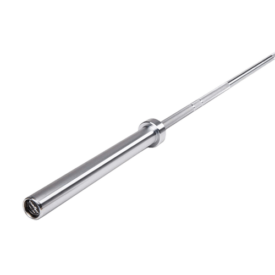
This barbell from Living.Fit features a multiple coating options and tough spring alloy steel. Designed as an all-around barbell, it sports 1.2mm knurling in patterns that accommodate both weightlifters and powerlifters.
Main Takeaways
- Living.Fit offers this barbell in chrome and cerakote. The cerakote version is ideal for those who don’t have their gear stashed in a climate-controlled room (as it provides the second highest level of protection to stainless steel), while the chrome is best suited for those who are keeping their workouts near some AC.
- The pairing of brass bushings and ball bearings in the loading sleeves is part of what makes this a highly versatile barbell, as this allows you to incorporate any style of lift you want. The moderate knurling also adds to this versatility.
- This barbell has a max weight capacity of 1,500 pounds and a tensile strength rating of 200,000 PSI. Tensile strength is the amount of force a bar can handle before it begins to bend or break. While elite-level athletes might want to target a bar closer to 230,000 PSI, this is plenty strong for most lifters.
Living.Fit Barbell Video Review
Our Reviews Writer, Jake, tested out both versions of the Living.Fit Barbell during his detailed video review. Follow along as he breaks down everything there is to know about this jack-of-all-trades barbell.
Living.Fit Barbell Highlights
- Price: $200 for the chrome version; $225 for the cerakote
- Weight Capacity: 1,500 pounds
- Tensile Strength: 200,000 PSI
- Coating: Chrome or Cerakote
- Intended Use: Can be used across all lifts
- Size: 20kg, 86.6 inches in length, 16-inch loading sleeves
Pricing is typically a huge obstacle that folks tend to deal with when purchasing gear for their home gym, and barbells can be quite pricey. With this high-quality barbell, you won’t spend more than $225 on your purchase, and that’s one of our favorite things about this bar.
This bar also offers a max weight capacity of 1,500 pounds and a tensile strength rating of 200,000 PSI. At this strength, functionally any athlete will find this barbell serviceable for their goals.
The coating here is another significant characteristic to consider. If you’re working out in a non-climate-controlled room, the cerakote version of this bar will be ideal, as it has the second highest level of protection against corrosion next to stainless steel. However, if your home gym is insulated and has heating and cooling, the chrome will suit you just fine.
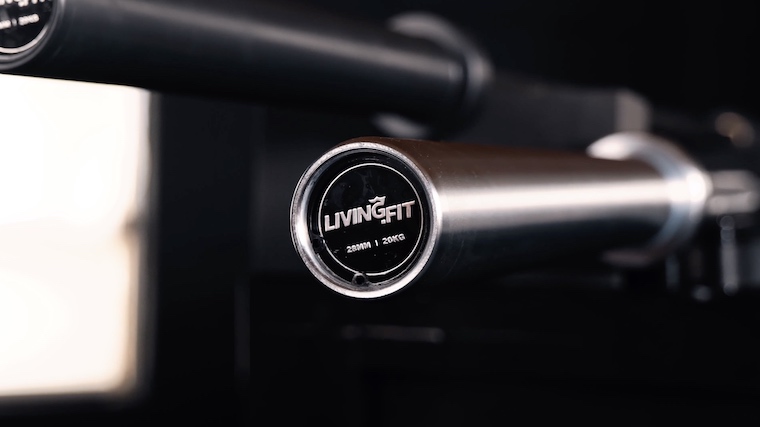
While some athletes may prefer a specialty bar for a specific style of lifting, the Living.Fit Barbell can be used for all lifts. Even though this bar may not be the absolute best at any one lift, the fact that it can be used across all of them will keep you from burning through all your cash on barbells alone.
This is a 20kg barbell that measures 86.6 inches long with 16.5-inch loading sleeves and a diameter of 28mm. So if you’re looking for a 10kg or 15kg barbell, you’ll have to look elsewhere.
Pros
- This barbell comes in both chrome and cerakote. The option to choose your coating ensures you’re getting adequate protection for the specific environment in which you stash your gear.
- Since you won’t be spending more than $225, this is an excellent barbell for those working within a tight budget.
- This barbell is highly versatile, which means you don’t have to buy or store multiple bars (if you don’t want to).
Cons
- While you can use this barbell across all lifts, those who emphasize one lifting style will likely find more success with a specialty bar. Olympic barbells offer more spin, while power bars feature a deeper cut knurling for a better grip.
- You will need to clean the chrome barbell more frequently than you will the cerakote bar to prevent corrosion from forming.
- Elite-level Olympic lifters will likely want a barbell with a higher tensile strength rating that can handle the heavy weights they are slamming to the ground.
Training With the Living.Fit Barbell
During our time with this barbell, we were thoroughly impressed with its performance during our Olympic and powerlifting movements.
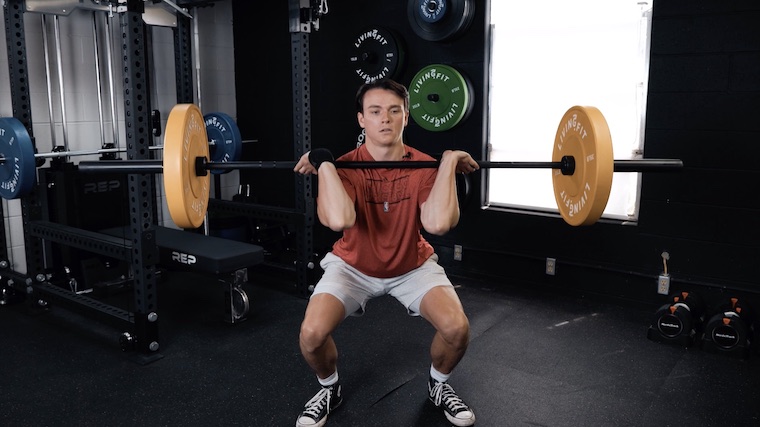
The bar spun at a rate that allowed us to rep some power cleans easily, and the knurling provided a grippy feel while we were bench pressing. Considering the relatively low price tag and high level of performance, we think this is one of the best bang for your buck barbells on the market.
Knurling
The knurling on a barbell is the crosshatch pattern where you grip the bar. It’s specifically designed to help your grip by increasing the amount of friction between your hands and the bar. While power bars feature a deep-cut pattern designed to give you a sticky-tack grip for benching, that’s not what you want with a multi-use barbell like this one.
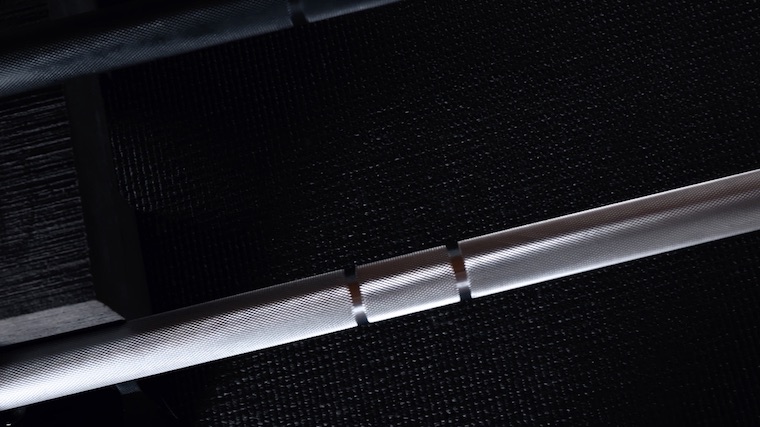
The knurling on this barbell is more moderate to accommodate a wider range of lifts, like cleans or snatches, which involve the bar rotating within your hands. We’ve tested plenty of other multi-use barbells like this one, and we found the knurling to be serviceable for movements like hang cleans, but too slippery for bench presses and shoulder presses. It was refreshing to find that this bar worked across all our lifts without compromising any part of our workouts.
Loading Sleeves
The loading sleeves of a barbell are another aspect that determines what a barbell is best suited for. Power bars only feature bushings and have minimal spin, while Olympic bars come equipped with ball bearings that allow the bar to spin freely. (The more spin you have during your dynamic weightlifting – movements, the better.)
Since the Living.Fit Barbell uses a combination of brass bushings and ball bearings in each of the loading sleeves, you’re getting the best of both worlds. It might not spin as much as a bar that only uses bearings, but the bushings are cheaper and degrade slower. Plus, they provide enough spin for you to practice your Olympic lifts without spinning on their own during powerlifts like back squats.
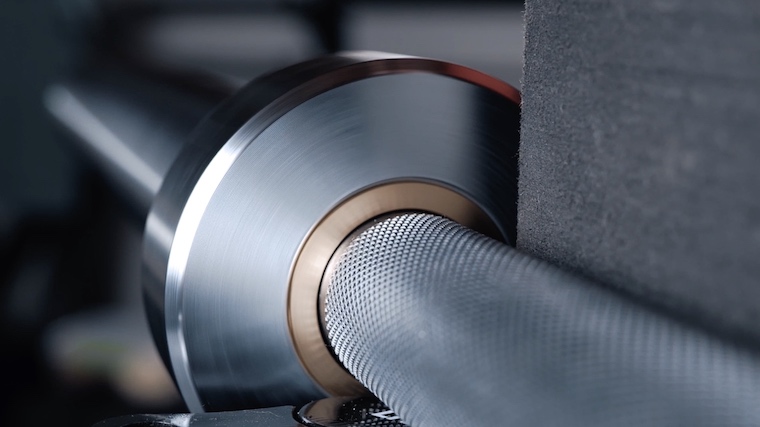
Overall, we were pleased with how this barbell performed during power clean (we could easily rotate the bar in our hands), and the sleeves stayed stationary when bench pressing. The only issue we had with the loading sleeves was that the finish scratched easily when loading weight plates (we’ll dig into that below).
Finish
Since Living.Fit offers this bar in both chrome and cerakote, you can purchase the one that suits your specific needs. The chrome works well for those who have their home gym in a climate-controlled room, but if it tends to get steamy in there, you’ll find that you need to clean your barbell frequently to keep corrosion from forming. Cerakote, on the other hand, is the second-best finish you could have on a barbell next to stainless steel as it is highly resistant against corrosion.
We also noticed that neither coating negatively affected our grip when lifting. Often, barbells with a coating can feel slippery compared to a fully stainless steel bar, so we appreciated that we didn’t find that to be the case here. However, we were a bit surprised that the finish on the loading sleeves had visible scratch marks after the first time we put bumper plates on. Don’t worry, this didn’t negatively impact the bar’s performance — it just isn’t very aesthetically pleasing.
What to Consider Before Buying the Living.Fit Barbell
Fortunately for us (and you), we got our hands on both versions of this barbell. And after spending time with them, we feel there are a few key factors you need to consider before deciding if the Living.Fit barbell is the right fit for your needs — specifically, the price, the materials, and the tensile strength.
Price
The chrome bar will run you around $200, while the cerakote is $225. The cerakote may be a better option since it offers more protection against rust and corrosion, and won’t need to be cleaned as frequently.
Workout Style
Since not everyone has the same goals or workout preferences, it’s best to understand your needs before purchasing a new barbell to be your trusty Excalibur.
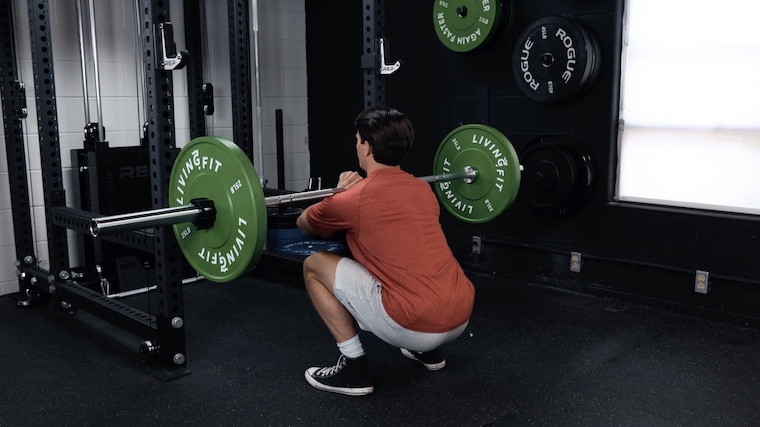
While the Living.Fit barbell is passable all lifts, it’s not necessarily the best option for any one lift. So if you’re a dedicated powerlifter or Olympic lifter, it might be best to target a specialty bar — like the REP Fitness Power Bar or the Rogue Olympic Weightlifting Bar. However, if you want to hit it all, this barbell is a solid choice.
Knurling
Nobody wants a barbell that doesn’t offer a good grip for their lifts, and that’s something you don’t have to worry about here. The knurling on this bar provides enough grip for heavy bench presses and deadlifts, but it’s also forgiving enough not to shred your hands as you go to do your Olympic or CrossFit exercises.
Tensile Strength
While it takes a lot to cause a barbell to bend, those tossing around some eye-popping weight need to keep the tensile strength of a bar in mind. The Living.Fit Barbell has a respectable rating of 200,000 PSI, which is plenty strong for most recreational athletes, but those who are in the upper echelon in strength might want to play it safe and target a bar that is closer to 230,000 PSI. (The strongest bar we’ve tested is the Force USA Gunner Barbell with a rating of 235,000 PSI.)
Living.Fit Barbell Vs. REP Fitness Colorado Bar
Barbells don’t vary too much in significant ways. Yes, there are specialty barbells, but differentiating between the standard models comes down to details. It helps to compare the specs. Some bars can handle more weight than others, pricing always varies, and the materials used can play a role in which bar will be the best call for you in the long haul. We wanted to put this barbell head-to-head against one of our other favorite barbells in 2025.
| Living.Fit Barbell — Chrome | Living.Fit Barbell — Cerakote | REP Fitness Colorado Bar — Chrome | REP Fitness Colorado Bar — Cerakote | |
| Price | $200 | $225 | $319 | $330 |
| Tensile Strength | 200,000 PSI | 200,000 PSI | 200,000 PSI | 200,000 PSI |
| Weight Capacity | 1,500 pounds | 1,500 pounds | 1,500 pounds | 1,500 pounds |
| Loading Sleeve Construction | Brass bushings with ball bearings | Brass bushings with ball bearings | Composite bushings | Composite bushings |
| Type of Barbell | Multi-Purpose | Multi-Purpose | Multi-Purpose | Multi-Purpose |
Both of these barbells can serve as the only barbell in your home gym, and they both feature the same tensile strength rating and weight capacity. The main reason for the price difference is the composite bushings in the Colorado Bar. They’re meant to last longer and offer a quieter experience than the brass bushings and ball-bearing combo in the Living.Fit Barbell. But for some, this may not affect the overall performance enough to warrant the extra $100.
Places to Buy
You can purchase the Living.Fit Barbell directly through the Living.Fit website.
Warranties
Living.Fit offers a lifetime warranty on this barbell that covers any manufacturing defects, but it does not cover negligent use, such as using faulty bumper plates.
Company Information
Living.Fit offers a wide range of strength equipment, as well as workout plans and courses you can follow. If you need to reach a team member, you can email them at info@living.fit, or via phone at 844-524-0677.
In Conclusion
Living.Fit offers a wide range of fitness equipment, and their cerakote barbell is one of our favorites on the market. While both the chrome and cerakote bars are high-quality, they’re available at a discounted price compared to similar products, as you won’t be spending more than $225 on either option. Other barbells are better suited for specific lifts, but this bar is tough to top when it comes to versatility on a budget.
FAQs
How much does the Living.Fit Barbell cost?
The price of this barbell depends on which coating you choose. The chrome version costs roughly $200, while the cerakote will cost you around $225. Regardless of your choice, this bar is a nice budget-friendly option.
What workouts can I do with the Living.Fit Barbell?
The beauty of this barbell is that it can accommodate pretty much any workout. You can easily hit your typical powerlifting movements, like bench presses and back squats, but the ball bearings in the loading sleeves make it possible to rep some power cleans as well.
What is the weight capacity of the Living.Fit Barbell?
This barbell can easily handle up to 1,500 pounds, which is enough to attempt the world record squat or deadlift.